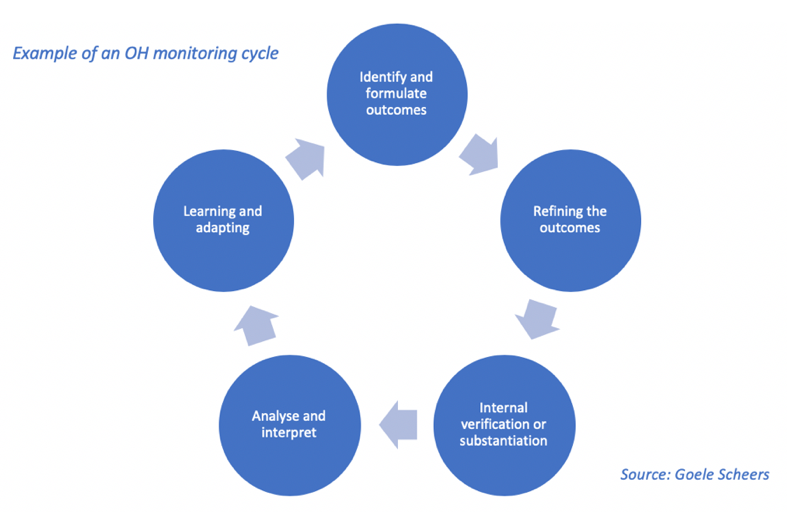Hi, I am Goele Scheers, an independent M&E consultant based in Belgium. I have worked closely with Ricardo Wilson-Grau since Outcome Harvesting (OH) was being developed and was working on an OH evaluation with him throughout his final year of life. I have always used OH for both monitoring and evaluation.
Outcome Harvesting works well for monitoring because staff engaged in implementing and monitoring the program can easily grasp “outcomes” as defined by OH, and take part in data collection, analysis and use of findings. OH can be combined with other methods to strengthen a monitoring system.
In a few ways, the use of Outcome Harvesting for monitoring is different than for evaluation. In an ongoing monitoring process, the steps occur in a cycle and don’t end with the use of findings. Instead of an external consultant who coaches the sources in formulating their outcomes, an organization will need to carefully consider who will harvest outcomes from who and on which level of the organization, network or partnership the ‘pingponging’ or refining of the outcomes will take place. Different methods for harvesting the outcomes (e.g., workshops, virtually) can be used within a single organization or program, depending on the use and the context. Most of my clients have found that identifying outcomes from documentation is less useful for monitoring, as the outcomes are being captured by the informants when they occur, that means on a continuous or at least frequent basis. Substantiation may not be included in every harvest cycle or it may even be left for evaluation. In some cases, I include a step on cross-organizational verification (very useful in networks or partnerships) or internal verification (checking the outcomes between different programs). In an ongoing monitoring process, the organization will need to decide at which point to analyze and interpret the harvested outcomes. For example, it may be that the informants upload their outcomes into a database at any point in time, but the analysis and interpretation only take place twice a year. Contrary to an external evaluation, the sources can be involved in the interpretation.
Lessons Learned: When using OH for monitoring, it can be challenging to keep the enthusiasm from the first harvesting round in subsequent rounds. Use of the harvest findings is the best motivator! Program staff are most likely to remain actively engaged in harvesting outcomes when they are able to use the findings to strengthen the program and its results.
Hot Tips:
- Incorporate the harvesting and sensemaking moments into existing spaces in the organization so it is not experienced as something additional that needs to be done.
- Organizations that use OH on an ongoing basis, will sooner or later need a database to store all the outcomes. Look into the tools the organization is using already to see if they can be adapted for OH. I’ve found Podio a very useful tool for harvesting, refining and storing the outcomes.
The American Evaluation Association is celebrating Outcome Harvesting week. The contributions all this week to aea365 come from colleagues of the late Ricardo Wilson-Grau, originator of Outcome Harvesting, and these articles are written in his honor. Do you have questions, concerns, kudos, or content to extend this aea365 contribution? Please add them in the comments section for this post on the aea365 webpage so that we may enrich our community of practice. Would you like to submit an aea365 Tip? Please send a note of interest to aea365@eval.org. aea365 is sponsored by the American Evaluation Association and provides a Tip-a-Day by and for evaluators.


We implement a program dubbed, Empowerment for Life (E4L) Program in Ghana, West Africa with funding from Ghana Venskab (Ghana Freinds) and Danish International Development Assistance (DANIDA) through Civil Society in Development (CISU) in Denmark. The program is in its third phase and implemented by the Ghana Developing Communities Association (GDCA) and Youth Empowerment for Life (YEfL) in Ghana.
We use outcome harvesting (OH) for monitoring mainly. We have outcome harvesting boxes at our district offices (four of them) in which outcomes harvested by staff are deposited. Outcome harvesting in E4L is done daily. Staff harvest outcomes when they observe one or beneficiaries report one during monitoring or activity implementation. Staff at the district level compile the outcomes harvested and add it to their quarterly reports submitted to me for analysis. We analyze the outcomes harvested semi-annually and annually.
In August 2019 I tried my first evaluation using the outcome harvesting approach. I did this with learning and inspiration from the evaluation report of Goele Scheers’s Outcome Harvesting Evaluation of ActionAid Denmark Tax Justice Programme. It was my first using OH for evaluation. I used OH to evaluate a project on internal revenue generation and utilization through tax dubbed, Enhancing Participation in Revenue Mobilization and Utilization (EPRM) in East Gonja Municipal Assembly in Ghana. This project was funded by the Star Ghana Foundation and implemented by GDCA.
The OH is helping a lot in our monitoring. We learn a lot from it and also able to tell good stories about the changes the E4L program is making in the communities to our partners, donors, beneficiaries and networks.
Thank you so much Ricardo Wilson-Grau for this great innovation which is changing the face of monitoring and evaluation in the world. My name is Suweidu Abdulai and I am the Monitoring, Evaluation and Research Officer of the E4L program and GDCA.